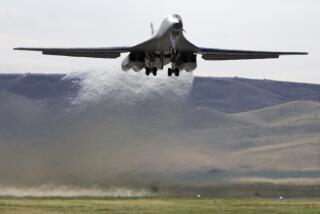B-1 Faults Attributed to AF Management Deficiencies
- Share via
WASHINGTON — The problems with the B-1 bomber go far deeper than a single weapon system and show a lack of communication and management ability within the Air Force, a top Pentagon official said Wednesday.
“The B-1B program is behind schedule and unfinished because of management deficiencies at all levels and spanning the life of the program,” John E. Krings told a pair of House Armed Services subcommittees.
Krings is director of the Pentagon’s operational test and evaluation office, a department created two years ago by Congress in the wake of congressional anger over a series of continuing problems of rising cost and poor performance of Pentagon weapons.
The problem is larger than the B-1, Krings said. “The fact is that these problems are inherent in all service cultures and in the acquisition system as a whole. There is little evidence of cross-community communication. There is no real accountability.”
Program Once Scrapped
The B-1, resurrected by President Reagan six years ago after President Jimmy Carter had killed the program in 1976, is the latest example of a problem-plagued weapons system.
In 1981, Congress approved 100 B-1s at a total cost of $20.5 billion, with the first planes to become operational last October. The planes met that target date and the Air Force has about 35 of the aircraft, but service officials have detailed a number of problems.
The B-1 is intended to replace the aging B-52 as the bomber component of the U.S. long-range nuclear strike force, which also includes submarine-launched missiles and land-based missiles.
However, the B-1 is too heavy and has serious deficiencies in its terrain-following radar, which is supposed to permit it to fly low under enemy defenses, and in its defensive electronic system, which is supposed to permit it to hide from opponents’ defenses.
Higher Cost
The Air Force says all the problems in the Rockwell-built bomber can be fixed, although it will bring the total cost of the program to an estimated $28.1 billion.
Investigations have shown that the 1981 decision to produce the plane at the same time that it was being tested caused many of the current troubles because problems that cropped up in tests could not be corrected before the bombers were manufactured.
But, that is not the whole problem, Krings said. He contended that the major deficiency was Carter’s decision to kill the program.
The Air Force was eventually given the job of managing the plane’s production, even though “no one questioned the ability of a service to carry out such a function. It was simply assumed,” he said.
Another problem was that, when the bomber was reborn in 1981, the earlier B-1A version was upgraded, but not with the latest technology available in more sophisticated planes such as fighters, he said.
“For years, the fighter community has been using technologies that could have been applied to the B-1B, but it is apparent that the fighter and bomber communities do not talk to each other,” he said.
More to Read
Sign up for Essential California
The most important California stories and recommendations in your inbox every morning.
You may occasionally receive promotional content from the Los Angeles Times.









